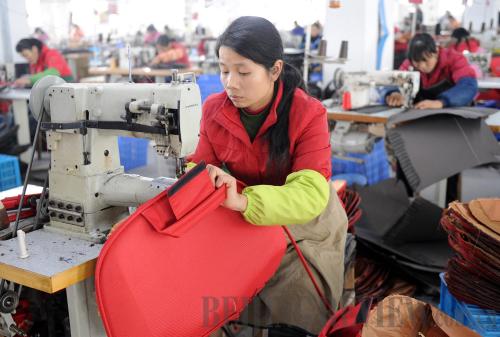|
Jobs for the jobless
|
 |
|
WORKING ATTENTIVELY: A worker at the Shijixing Case and Bag Factory in Xingan County, Jiangxi Province, sews a bag. Bag factories in the county provide more than 8,000 jobs to local residents (ZHOU KE) | In 2009, the Chinese Government spared no efforts to stimulate the job market, Yin said.
The government gave tax breaks to companies, especially for small and medium-sized enterprises (SMEs), which employ 80 percent of the labor force, to help them through the difficult financial times. MOHRSS joined hands with the Ministry of Finance and the State Administration of Taxation to work out a subsidy mechanism for ailing companies. The procedure allows companies undergoing hard times to postpone handing in certain social security insurance paperwork—specific to pension, health care, unemployment and work-related injury policies—and delay making contributions to the housing provident fund. It also reduces the premium rates paid by those companies and distributes unemployment insurance benefits to troubled companies that do not lay off workers. The Chinese Government has also deployed funds to train workers in those companies.
In March and June 2009, the State Council held two executive meetings to examine employment and related issues, which worked out four documents pertaining to advancing employment by embarking on new projects and promoting employment of college graduates and migrant workers. In the meantime, the Central Government also dedicated large financial sums to spur job growth, appropriating 42 billion yuan ($6.15 billion) to employment, a 66.7-percent surge from 2008. By July 2009, more than 300 cities in 31 provinces, municipalities and autonomous regions had come up with their own measures promoting employment.
Yin said from January to September 2009, altogether 25.72 million people benefited from various employment promotion measures, and 31.8 billion yuan ($4.65 billion) in employment funds from the Central Government had been used.
The Social Blue Book issued by the Chinese Academy of Social Sciences on December 21, 2009, showed the employment situation remaining stable at the end of the third quarter of 2009 as job vacancies and job seekers had begun increasing steadily. The number of newly added urban employees hit 8.51 million. About 4.02 million laid-off workers had been reemployed. The registered urban unemployed personnel had numbered 9.15 million, with the unemployment rate standing at 4.3 percent.
The employment of three groups of people who were most affected by the financial crisis—college graduates, migrant workers and those who have been unemployed for several months or more—remained stable. Yin said the employment rate of 2009 graduates reached 74 percent, almost the same as 2008. The majority of migrant workers who had returned home successfully had found jobs by the end of October 2009. From January to November 2009, 1.46 million people who had difficulty finding a stable job had been reemployed, exceeding the 1 million target set by the Central Government in early 2009.
"It's not easy for China to maintain a sound and stable employment rate against the backdrop of the global job crisis," said Yin.
Future obstacles
Despite signs of job stabilization, Yin said more efforts are needed to secure future jobs.
To follow up on the economic prosperity of 2009, the Central Government established employment targets to create 9 million jobs for the newly added urban labor force and 5 million jobs for laid-off workers. Keeping the urban unemployment rate under 4.6 percent is also an essential part of the target for 2010.
To achieve its goal, Yin said the government will foster new economic growth engines, develop new industries and promote science and technology advancements. More attention will also be given to labor-intensive companies, SMEs, private economies and the service industry to create jobs. The government has also started to encourage people to set up businesses of their own.
But those measures are meant to address the current employment problem, rather than prepare for future occurrences, said Yao Jingyuan, chief economist of the National Bureau of Statistics.
Yao said according to figures from the United Nations, under the population division involving the population within the productive age (referring to those between 16 and 65), China had 909 million eligible workers in 2004.
"What does that mean? The total combined populations of the seven most developed countries in the world—the United States, Japan, Germany, the United Kingdom, France, Italy and Canada—is 300 million less than the population within the productive age in China," Yao said. "This is the dilemma we are facing now."
The employment pressure on college graduates might be the largest. The number of graduates in 2009 was 6.1 million, a number that will remain constant in years to come, all of whom will seek employment. In addition, there are many young people who fail to enter universities and will also need to find jobs.
Each year, 12 million young people between the ages of 18 and 22 need jobs.
"The employment demand of this specific group is equivalent to the overall job demands of a European country. That's why we say the job pressure in China is the biggest in the world," said Yao.
The enormous pressure has always been and will continue to be a test of the Chinese Government's ability to address job-related problems, Yao concluded. | 